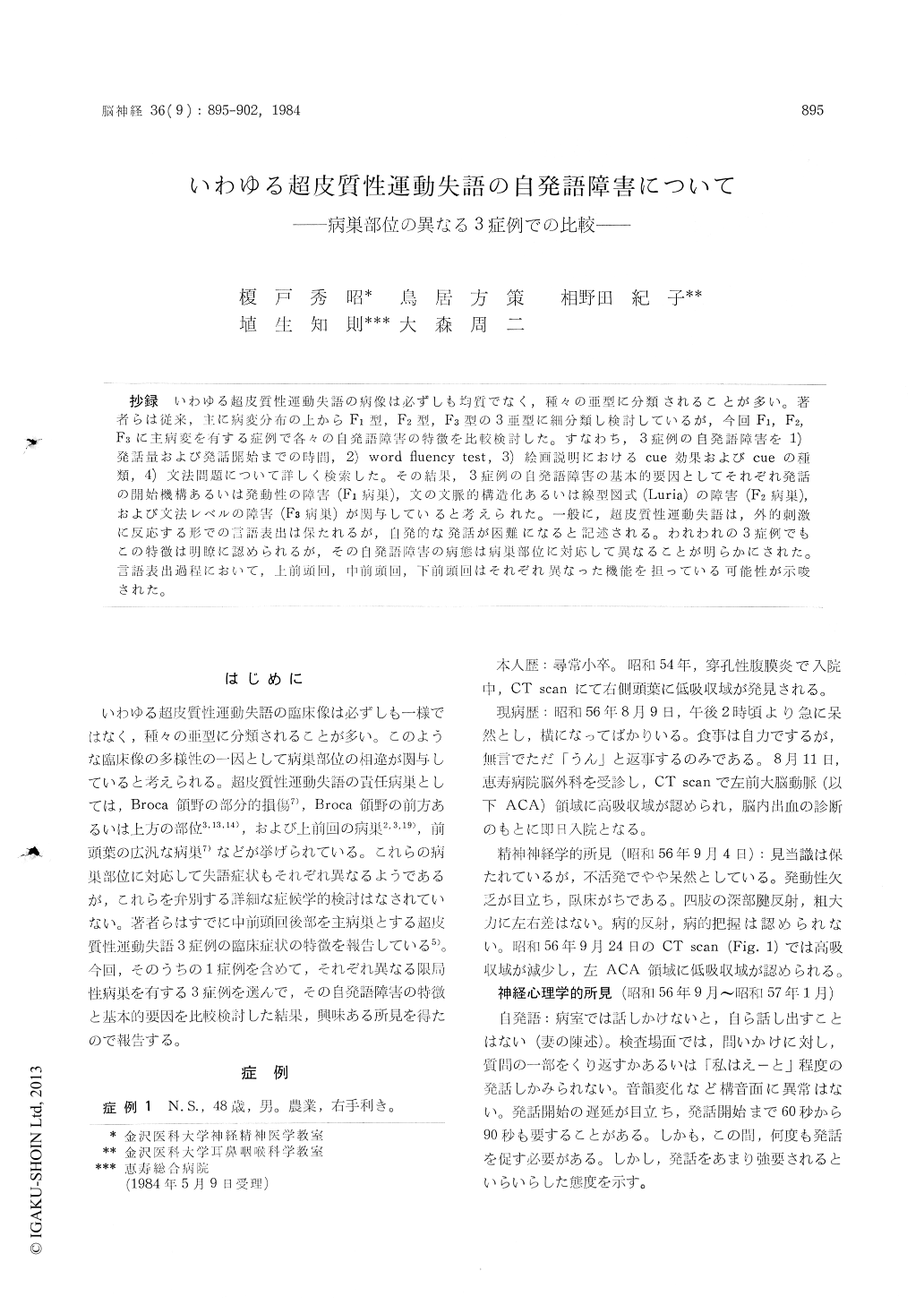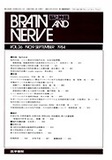Japanese
English
- 有料閲覧
- Abstract 文献概要
- 1ページ目 Look Inside
抄録 いわゆる超皮質性運動失語の病像は必ずしも均質でなく,種々の亜型に分類されることが多い。著者らは従来,主に病変分布の上からF1型,F2型,F3型の3亜型に細分類し検討しているが,今回F1,F2,F3に主病変を有する症例で各々の自発語障害の特徴を比較険討した。すなわち,3症例の自発語障害を1)発話量および発話開始までの時間,2) word fiuency test,3)絵画説明におけるcue効果およびcueの種類,4)文法問題について詳しく検索した。その結果,3症例の自発語障害の基本的要因としてそれぞれ発話の開始機構あるいは発動性の障害(F1病巣),文の文脈的構造化あるいは線型図式(Luria)の障害(F2病巣),および文法レベルの障害(F3病巣)が関与していると考えられた。一般に,超皮質性運動失語は,外的刺激に反応する形での言語表出は保たれるが,自発的な発話が困難になると記述される。われわれの3症例でもこの特徴は明瞭に認められるが,その自発語障害の病態は病巣部位に対応して異なることが明らかにされた。言語表出過程において,上前頭回,中前頭回,下前頭回はそれぞれ異なった機能を担っている可能性が示唆された。
So called transcortical motor aphasia (TCMA) is frequently subdivided, because the clinical fea-tures and the localization of the lesions are vari-able. The authors have been attempting to classify TCMA into three types according to the distribu-tion of the lesions, such as Type F 1, Type F 2 and Type F 3.
Case 1 N. S. belongs to Type F 1 showing the clinical features of TCMA with bleeding in the territory of the left anterior cerebral artery. Case 2 M. E. belongs to Type F 2 (published case). This case is similar to Luria's dynamic aphasia in its clinical features and results from the lesions includ-ing the posterior parts of left middle frontal gyrus. Case 3 N. T. belongs to Type F 3 who recoveredfrom typical Broca aphasia after language training for four years. The case is similar to Goldstein's Type 1 of TCMA in its clinical features.
These three cases are compared with regard to the fundamental bases of spontaneous speech dis-turbance. The items of comparison are as follows ; 1) the volume of speech production and the the time taken to start speech, 2) word fluency test, 3) cue effects necessary for the success of sentence constructions 4) grammatical ability. The results are summerized in Table 2.
Type F1 shows the most conspicuous defect of spontaneous speech, but no disturbance in gram-matical ability. And when the top word of a sen-tence (a subject word) is given by the examiner, the patient can construct a structurally cerrect sentence. These findings imply that the spontaneous speech disturbance of Type F1 is due to a defect of the starting mechanism of speech. This is the reason that although the language abilities at syntactic, semantic and phonemic levels are well preserved, yet the spontaneous speech is markedly disturbed in this type. Type F2 shows a moderate decrease of speech production and a slight ditur-bance in grammatical ability. The most strikingfeature of Type F 2 is the apparent recovery of the ability in sentence construction gained through the cue of sentence pattern given by the examiner. This phenomenon seems to be similar to the de-fects of "linear schema of phrase" (Luria). Type F 3 shows marked defects in grammatical ability and then no recovery in sentence construction even if the patient is given some cues.
From the above mentioned test results, the fun-damental bases for the speech disturbances in these three types are summerized as follows;
Type F 1:disturbance of starting mechanism or spontaneity in speech production,
Type F 2:disturbance of finding the contextual sentence structure or "linear schema of phrase" (Luria),
Type F 3:disturbance of grammatical level.
These findings reveal that the fundamental bases for spontaneous speech disturbances in TCMA vary according to the distribution of lesions. It seems likely that the posterior parts of Fl, F 2 and F 3 may play different roles in the expressive processes of language.

Copyright © 1984, Igaku-Shoin Ltd. All rights reserved.


